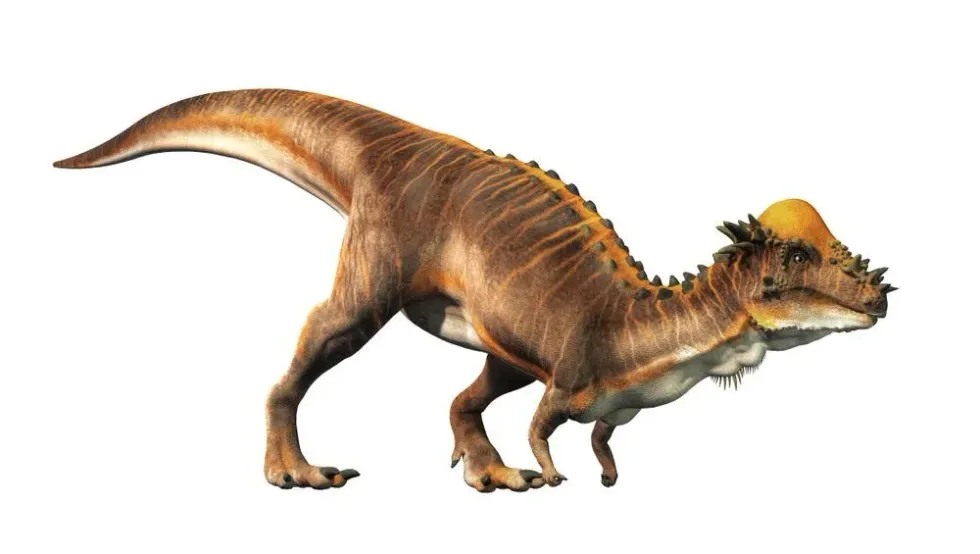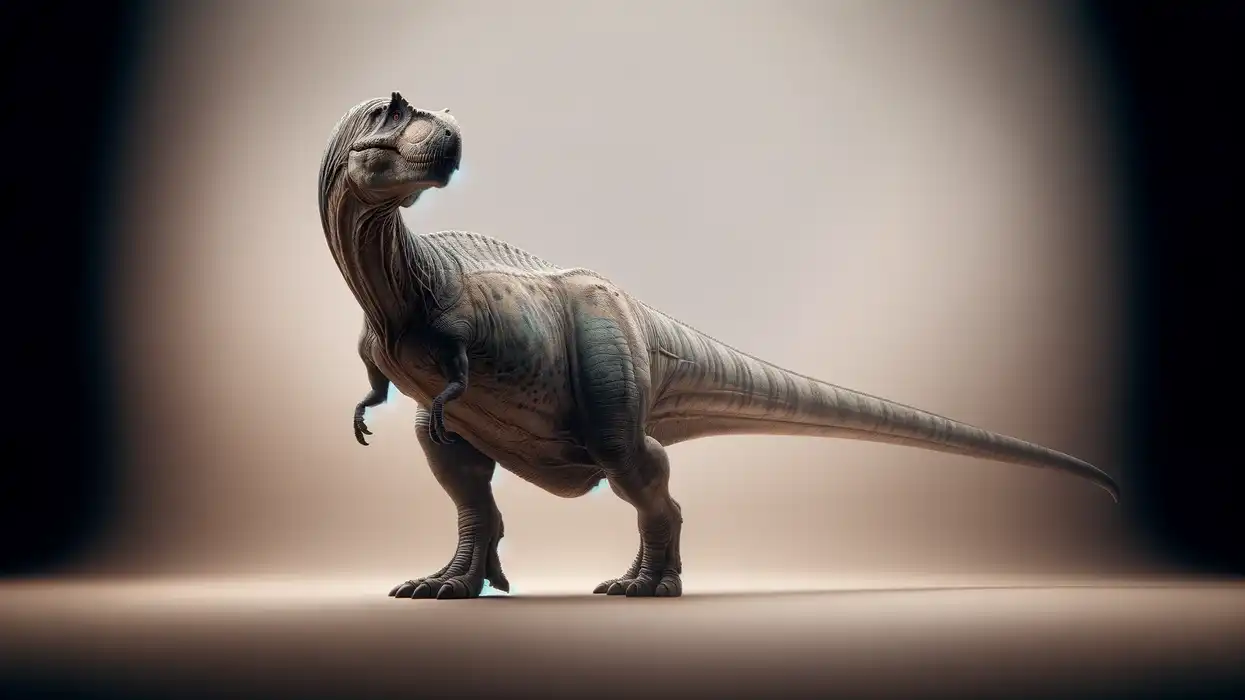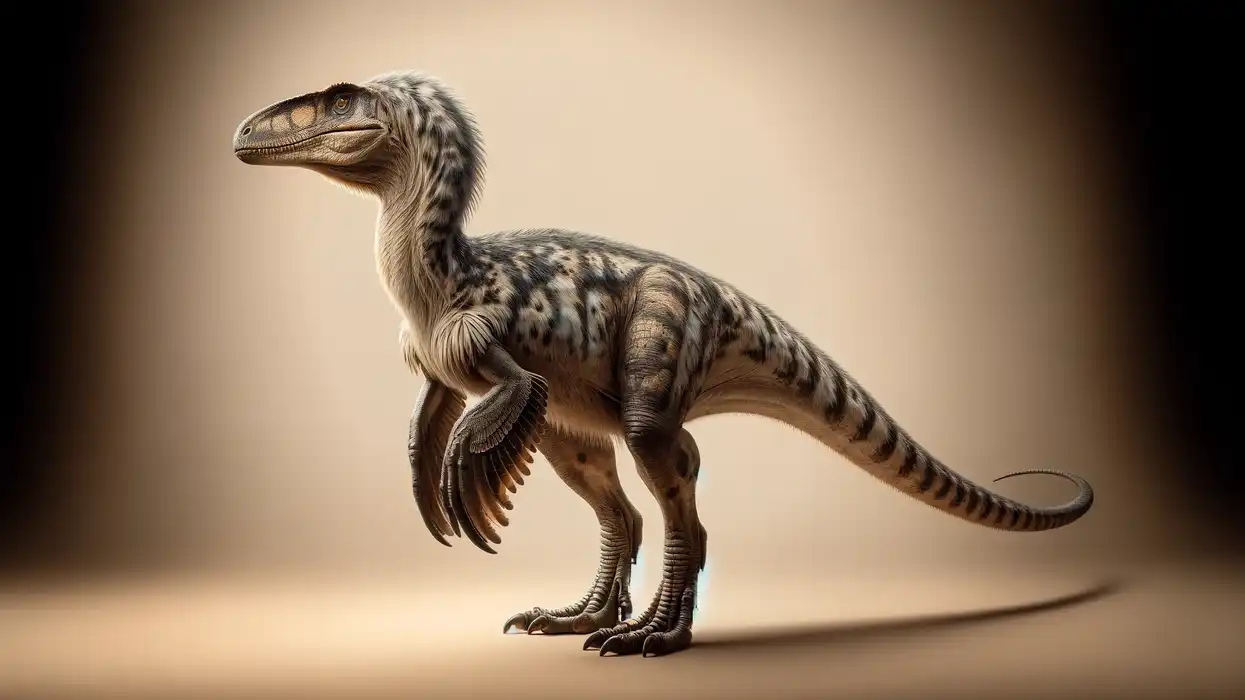The Micropachycephalosaurus is a small dinosaur that lived during the Late Cretaceous period, 66 million years ago. This dinosaur was originally considered a part of the Pachycephalosauridae family but was finally considered an indeterminant member of the Cerapoda order.
It used to live in the woodlands and grasslands of China and the first fossil was found on a cliff in China. It was found alone and incomplete; without its head.
The absence of its head led to problems in its identification and classification. These dinosaurs were herbivores and fed on plants, fruits, and seeds. The female laid up to 21 eggs during the breeding season.
They were greenish-yellow in color with a white or off-white stripe running across the sides of their bodies. It was a bipedal dinosaur that traveled on its hind legs.
The hind legs were usually much stronger and longer in bipedal dinosaurs while the forelimbs were shorter. A very popular and well-known bipedal dinosaur is the Tyrannosaurus rex which also lived during the Late Cretaceous period.
If you liked reading about the Micropachycephalosaurus, you should also check out some interesting facts about the Callovosaurus and Huaxiaosaurus.
Micropachycephalosaurus Interesting Facts
How do you pronounce 'Micropachycephalosaurus'?
The Micropachycephalosaurus pronunciation is 'mike-row-pak-ee-seff-ah-loh-sore-us'.
What type of dinosaur was a Micropachycephalosaurus?
The Micropachycephalosaurus was a monotypic genus of a ceratopsian dinosaur. Ironically, it contradicts its name and is not a member of Pachycephalosauria like it was originally thought to be.
In which geological period did Micropachycephalosaurus roam the Earth?
The Micropachycephalosaurus roamed the earth during the Mesozoic geological period around 66-100 million years ago. It lived during the Late Cretaceous period.
When did the Micropachycephalosaurus become extinct?
The Micropachycephalosaurus became extinct when a meteor hit the Earth 66 million years ago.
Where did Micropachycephalosaurus live?
The Micropachycephalosaurus lived in present-day China. The first fossil was found on a cliff in Laiyang, Shandong Province.
What was the Micropachycephalosaurus' habitat?
Since the Micropachycephalosaurus had a herbivorous diet they lived in areas with lush greenery. They lived in habitats with immense vegetation, like natural woodlands and grasslands.
Who did Micropachycephalosaurus live with?
Many dinosaurs often lived in herds and were gregarious animals, and juveniles were almost often always in a group. However, the Micropachycephalosaurus could have been a solitary dinosaur or a herder. Since its fossil was found solitary, it is assumed that they lived alone.
How long did a Micropachycephalosaurus live?
The exact lifespan or age of a Micropachycephalosaurus is not known. Very little is known about their lifespan or life cycle.
How did they reproduce?
Micropachycephalosaurus, like other dinosaurs, reproduced by laying eggs. Micropachycephalosaurus are oviparous and can lay up to 21 eggs, out of which juveniles hatched after a certain incubation period. The female would lay the eggs after internal fertilization takes place.
Micropachycephalosaurus Fun Facts
What did Micropachycephalosaurus look like?
 We've been unable to source an image of a Micropachycephalosaurus and have used an image of a Pachycephalosaur instead. If you are able to provide us with a royalty-free image of a Micropachycephalosaurus, we would be happy to credit you. Please contact us at hello@kidadl.com
We've been unable to source an image of a Micropachycephalosaurus and have used an image of a Pachycephalosaur instead. If you are able to provide us with a royalty-free image of a Micropachycephalosaurus, we would be happy to credit you. Please contact us at hello@kidadl.com Very little information is available regarding the description of the Micropachycephalosaurus dinosaur because only one incomplete fossil specimen has been discovered and conserved in a museum. Its skin is rough and bumpy with scales and greenish-yellow in color.
The dinosaur has a white stripe along the length of its body on its back and flanks.
It was earlier considered to be a member of Pachycephalosauria but later this claim was not accepted because it didn't have the distinctive feature of a dome-shaped thickened skull.
Since a complete skull or fossil was not available there was no way to prove that they had a thickened skull like other Pachycephalosaur dinosaurs, thus they were not proven to be directly related. It was very small in size and had a tail that is approximately half as long as its total length.
It was a bipedal dinosaur. Since it was a herbivorous dinosaur, the assumption can be made that it probably had small teeth which would use to chew its food.
The jaw was triangular and extended forward and the head was small with a long, narrow snout.
How many bones did a Micropachycephalosaurus have?
The exact number of bones in the Micropachycephalosaurus, a small thick-headed dinosaur, is not currently known. Researchers found it hard to estimate the number of bones that this dinosaur would have had because the fossil found in China was incomplete.
How did they communicate?
Like other dinosaurs, it can be assumed that the Micropachycephalosaurus dinosaur communicated using their bodies and vocalization. Dinosaurs created distinct open-mouthed sounds and closed-mouthed sounds to communicate.
The dinosaur groups use special features like skull domes, chest plate armor, and frills to communicate during mating rituals and to choose and impress mates, to scare rival dinosaurs, or to dominate other dinosaurs in the herd.
How big was the Micropachycephalosaurus?
The dinosaur from the Micropachycephalosaurus genus was very small. The Micropachycephalosaurus size is 17 in (4.18 cm) long and 7.8-11.8 in (20-30 cm) tall. Its tail was around half its total length; 8 in (20.3 cm). It was two times shorter than a Labrador Retriever and was around the same size as an Egyptian Mau.
How fast could a Micropachycephalosaurus move?
The Micropachycephalosaurus could run very fast. Since they were small in size the only way they could protect themselves from larger carnivorous dinosaurs was to run.
Their light weight and small size helped them attain agility. The exact speed of the Micropachycephalosaurus is unknown. Dinosaur speeds are estimated using their footprints which are found under layers of earth after excavation.
How much did a Micropachycephalosaurus weigh?
The Micropachycephalosaurus was a small and lightweight dinosaur. It weighed 5-10 lb (2.26-4.5 kg) which is the same as a Papillon Chihuahua and three times heavier than a frilled lizard.
What were the male and female names of the species?
There are no sex-specific names for the male and female dinosaurs of this genus.
What would you call a baby Micropachycephalosaurus?
There is no particular name for a baby Micropachycephalosaurus.
What did they eat?
The Micropachycephalosaurus had a herbivorous diet. They probably ate a range of plants, fruits, and seeds, as a part of their regular diet.
Like most herbivores, they had a row of small sharp teeth in their jaw that help them chew a variety of food. Even though they were bipedal dinosaurs, they often went on all fours when they were eating or foraging in their habitat.
How aggressive were they?
They were not very aggressive. Since they were small dinosaurs, there were more chances of them being prey to other, larger dinosaurs. They had well-developed defensive tactics rather than offensive tactics. As they were very fast and agile they ran away at the sign of danger.
Did you know...
The Micropachycephalosaurus is one of the smallest dinosaurs in the world. The smallest non-avialan dinosaur in the world is the Parvicursor remotus.
The name Micropachycephalosaurus is the longest dinosaur name in the world with 23 letters and 9 syllables.
The skull is one of the missing pieces of the dinosaur fossil from the museum collection. It is an extremely important part of identifying and classifying the dinosaur.
Why are they called Micropachycephalosaurus?
The name, 'Micropachycephalosaurus' can be broken into micro, pachy, cephalo, and saurus. The full meaning is 'small thick-headed lizard.'
It was named by Dong in 1978 and was described as a Pachycephalosauria member.
In 2008, two paleontologists, Butler and Zhao, used modern methods and failed to find any characteristics similar to that found in pachycephalosaurs. Since the fossil was incomplete and missing the skull, which is the most important part of the skeleton when it comes to identifying pachycephalosaurs, Butler and Zhao, classified it as an indeterminate member of the Cerapoda order.
Who discovered the Micropachycephalosaurus?
These small, thick-headed, lizard dinosaurs from the Late Cretaceous time period were discovered and named by paleontologist Dong in 1978.
Here at Kidadl, we have carefully created lots of interesting family-friendly dinosaur facts for everyone to discover! Learn more about some other dinosaurs from our Dakotadon facts and Cerasinops facts pages.
You can even occupy yourself at home by coloring in one of our free printable Micropachycephalosaurus coloring pages.
*We've been unable to source an image of a Micropachycephalosaurus and have used an image of a Pachycephalosaur instead. If you are able to provide us with a royalty-free image of a Micropachycephalosaurus, we would be happy to credit you. Please contact us at hello@kidadl.com









